The iPhone 5s Review
by Anand Lal Shimpi on September 17, 2013 9:01 PM EST- Posted in
- Smartphones
- Apple
- Mobile
- iPhone
- iPhone 5S
Display
The iPhone 5s, like the iPhone 5c, retains the same 4-inch Retina Display that was first introduced with the iPhone 5. The 4-inch 16:9 LCD display features a 1136 x 640 resolution, putting it at the low end for most flagship smartphones these days. It was clear from the get-go that a larger display wouldn’t be in the cards for the iPhone 5s. Apple has stuck to its two generation design cadence since the iPhone 3G/3GS days and it had no indication of breaking that trend now, especially with concerns of the mobile upgrade cycle slowing. Recouping investment costs on platform and industrial design are a very important part of making the business work.

Apple is quick to point out that iOS 7 does attempt to make better use of display real estate, but I can’t shake the feeling of being too cramped on the 5s. I’m not advocating that Apple go the route of some of the insanely large displays, but after using the Moto X for the past month I believe there’s a good optimization point somewhere around 4.6 - 4.7”. I firmly believe that Apple will embrace a larger display and branch the iPhone once more, but that time is just not now.
The 5s’ display remains excellent and well calibrated from the factory. In an unusual turn of events, my iPhone 5c sample came with an even better calibrated display than my 5s sample. It's a tradeoff - the 5c panel I had could go way brighter than the 5s panel, but its black levels were also higher. The contrast ratio ended up being very similar between the devices as a result. I've covered the panel lottery in relation to the MacBook Air, but it's good to remember that the same sort of multi-source components exist in mobile as well.
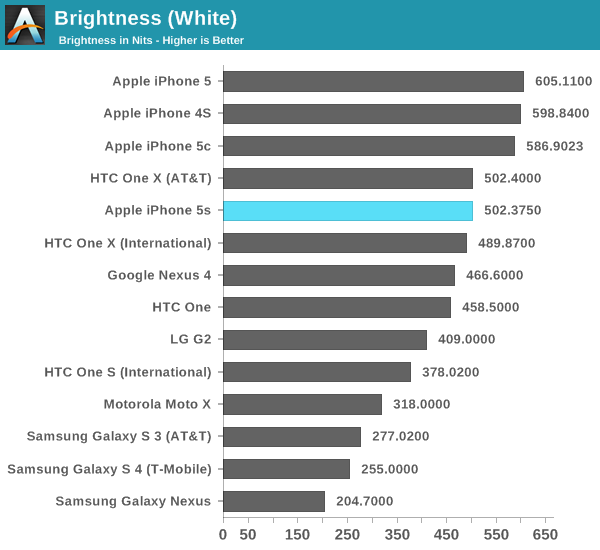
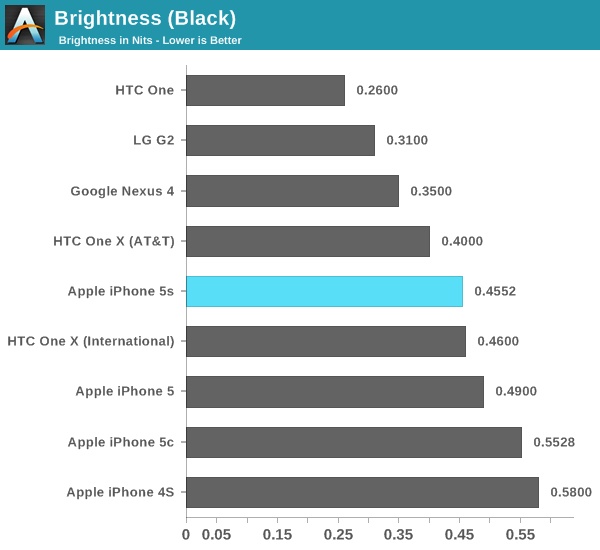
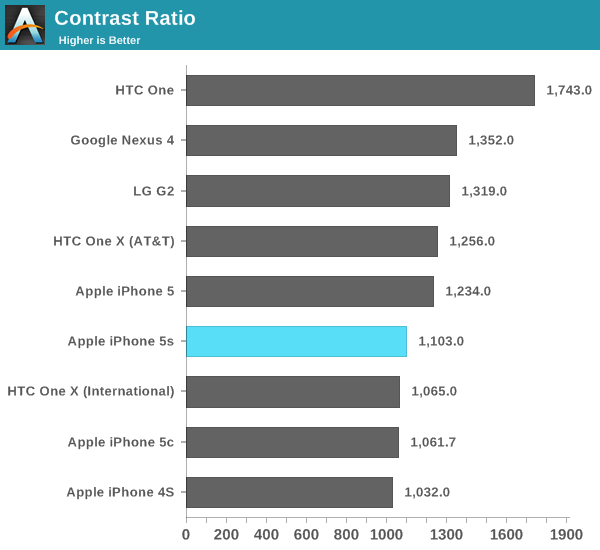
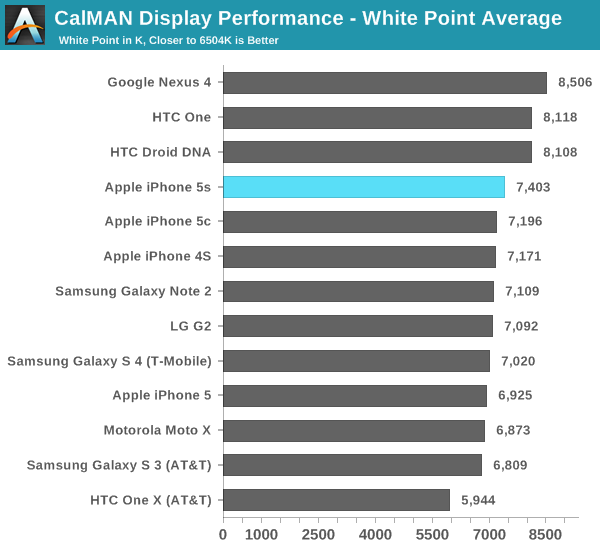

Color accuracy is still excellent just out of the box. Only my iPhone 5c sample did better than the 5s in our color accuracy tests. Grayscale accuracy wasn't as good on my 5s sample however.
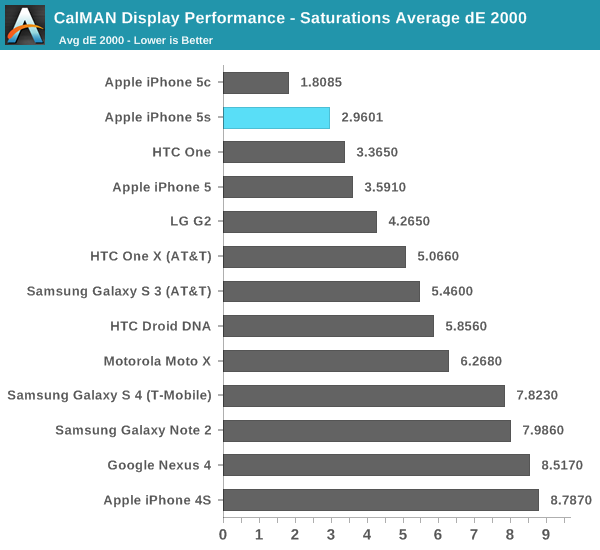
Saturations:

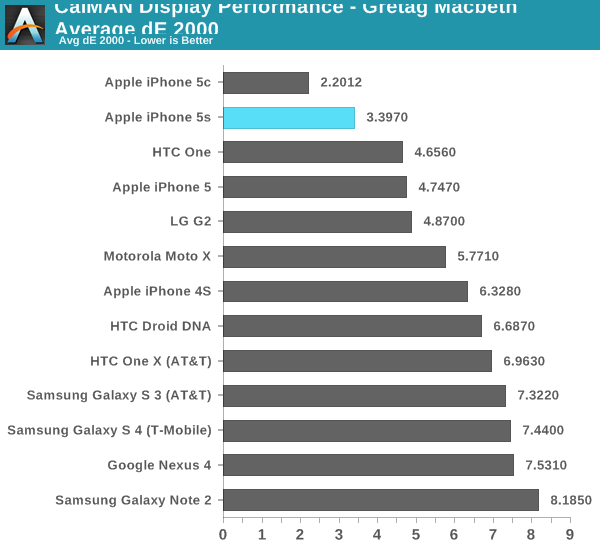
GMB Color Checker:

Cellular
When early PCB shots of the 5s leaked, I remember Brian counting solder pads on the board to figure out if Apple moved to a new Qualcomm baseband solution. Unfortunately his count came out as being the same as the existing MDM9x15 based designs, which ended up what launched. It’s unclear whether or not MDM9x25 was ready in time in order to be integrated into the iPhone 5s design, or if there was some other reason that Apple chose against implementing it here. Regardless of the why, the result is effectively the same cellular capabilities as the iPhone 5.
Apple tells us that the wireless stack in the 5c and 5s is all new, but the lack of LTE-Advanced features like carrier aggregation and Category 4 150Mbps downlink make it likely that we’re looking at a MDM9x15 derivative at best. LTE-A support isn’t an issue at launch, however as Brian mentioned on our mobile show it’s going to quickly become a much needed feature for making efficient use of spectrum and delivering data in the most power efficient way.
The first part is relatively easy to understand. Carrier aggregation gives mobile network operators the ability of combining spectrum across non-contiguous frequency bands to service an area. The resulting increase in spectrum can be used to improve performance and/or support more customers on LTE in areas with limited present day LTE spectrum.
The second part, improving power efficiency, has to do with the same principles of race to sleep that we’ve talked about for years. The faster your network connection, the quicker your modem can transact data and fall back into a lower power sleep state.
The 5s’ omission of LTE-A likely doesn’t have immediate implications, but those who hold onto their devices for a long time will have to deal with the fact that they’re buying at the tail end of a transition to a new group of technologies.
In practice I didn’t notice substantial speed differences between the iPhone 5s, 5c and the original iPhone 5. My testing period was a bit too brief to adequately characterize the device but I didn’t have any complaints. The 5s retains the same antenna configuration as the iPhone 5, complete with receive diversity. As Brian discovered after the launch, the Verizon iPhone 5s doesn’t introduce another transmit chain - so simultaneous voice and LTE still aren’t possible on that device.
Apple is proud of its support for up to 13 LTE bands on some SKUs. Despite the increase in support for LTE bands there are a lot of iPhone 5s SKUs that will be shipped worldwide:
| Apple iPhone 5S and 5C Banding | |||||||
| iPhone Model | GSM / EDGE Bands | WCDMA Bands | FDD-LTE Bands | TDD-LTE Bands | CDMA 1x / EVDO Rev A/B Bands | ||
|
5S- A1533 (GSM) |
850, 900, 1800, 1900 MHz | 850, 900, 1700/2100, 1900, 2100 MHz | 1, 2, 3, 4, 5, 8, 13, 17, 19, 20, 25 | N/A | N/A | ||
|
5S- A1533 (CDMA) |
800, 1700/2100, 1900, 2100 MHz | ||||||
|
5S- A1453 |
1, 2, 3, 4, 5, 8, 13, 17, 18, 19, 20, 25, 26 | ||||||
|
5S- A1457 5C- A1507 |
850, 900, 1900, 2100 MHz | 1, 2, 3, 5, 7, 8, 20 | N/A | ||||
|
5S- A1530 5C- A1529 |
1, 2, 3, 5, 7, 8, 20 | 38, 39, 40 | |||||
| Apple iPhone 5S/5C FCC IDs and Models | |||
| FCC ID | Model | ||
| BCG-E2642A | A1453 (5S) A1533 (5S) | ||
| BCG-E2644A | A1456 (5C) A1532 (5C) | ||
| BCG-E2643A | A1530 (5S) | ||
| BCG-E2643B | A1457 (5S) | ||
| BCG-E2694A | A1529 (5C) | ||
| BCG-E2694B | A1507 (5C) | ||
WiFi
WiFi connectivity also remains unchanged on the iPhone 5s. Dual band (2.4/5GHz) 802.11n (up to 150Mbps) is the best you’ll get out of the 5s. We expected Apple to move to 802.11ac like some of the other flagship devices we’ve seen in the Android camp, but it looks like you’ll have to wait another year for that.
I don’t believe you’re missing out on a lack of 802.11ac support today, but over the life of the iPhone 5s I do expect greater deployment of 802.11ac networks (which can bring either performance or power benefits to a mobile platform).
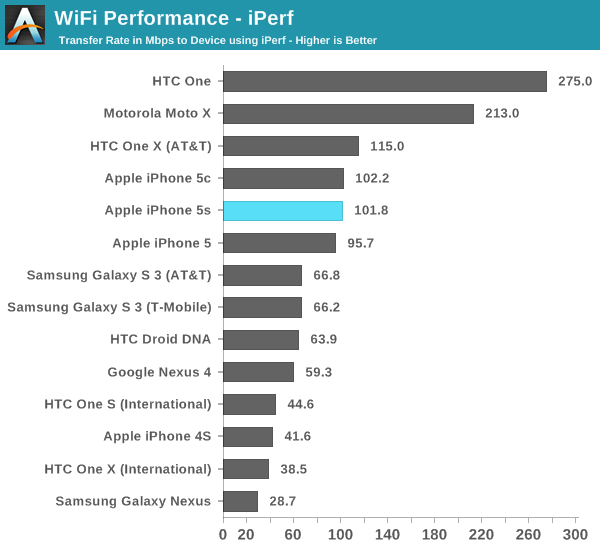
WiFi performance seems pretty comparable to the iPhone 5. The HTC One and Moto X pull ahead here as they both have 802.11ac support.













464 Comments
View All Comments
teiglin - Wednesday, September 18, 2013 - link
There is absolutely no basis to compare the process tech between A7 and Bay Trail. We know what battery life the A7 affords the iPhone 5s, but know nothing about what sort of battery life Silvermont might provide in a smartphone form factor. If those Oscar cores are really as power-efficient as Silvermont, then yes, that'd be amazing evidence of A7's power-efficiency.Wilco1 - Wednesday, September 18, 2013 - link
Given a 2.4GHz Bay Trail in a development board already cannot keep up with the A7 at 1.3GHz (A7 beats it by a huge margin on Geekbench), there is no hope for BT-based phones. BT would need to be clocked far lower to fit in a total phone TDP of ~2W, which means it loses out even worse on performance against A7, Krait and Cortex-A15.So yes, the fact that Bay Trail is already beaten by a phone before it is even for sale is a sign of things to come. 2014 will be a hard year for Intel given 20nm TSMC will give further performance and power efficiency gains to their competitors. It all starts to sound a lot like a repeat of the old Atom...
vcfan - Wednesday, September 18, 2013 - link
"Apple's designs are superior to Intel's. and then, Intel had better watch out."first of all, its arm vs x86. and second, it was "LOLz intel cant do low power chips,arm wins", now its "but but intel is 22nm" . hilarious.
ScienceNOW - Wednesday, September 18, 2013 - link
WE have plenty of time until 5nm, by that time most likely something New will be in place to pick up where silicone leftsolipsism - Tuesday, September 17, 2013 - link
Since when is a PS4 a desktop machine? And why only look at the GPU and not at the CPU that was clearly referenced?Crono - Tuesday, September 17, 2013 - link
Ha, I love the low-light image choice of subject. :DYou have to admit, it seems like Apple learned some things from Nokia and HTC this round to improve their cameras, though the combination dual flash is pretty ingenious. I'm wondering if the other manufacturers will adopt it or stick to single LED and Xenon flashes.
StevoLincolnite - Tuesday, September 17, 2013 - link
My Lumia has dual LED flashes, the Lumia 928 has dual Xenon flashes.So it's hardly anything new when the Lumia 920 has been on the shelf for almost a year.
whyso - Tuesday, September 17, 2013 - link
My HTC raider from 2011 has dual LED flash.Ewram - Wednesday, September 18, 2013 - link
my HTC Desire HD (HTC Ace) has dual led, bought it november 2010.melgross - Wednesday, September 18, 2013 - link
I think you missed the explanation of what Apple did here. The dual flashed in the past, and in yours and other current devices are just two flashes of exactly the same type. Apple's is one cold temp flash and one warm temp flash. The camera flashes before it takes the photo, then evaluates the picture quality based on color temperature. It then comes up with a combination of flash exposure that varies the amount each flash generates so as to give the proper color rendering, and well as the correct exposure.No other camera does that. Not even professional strobes can do that. I wonder if Apple patented the electronics and software used for the evaluation.